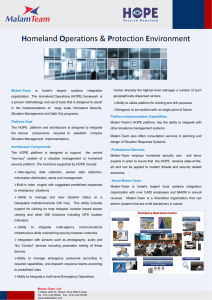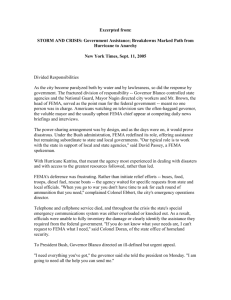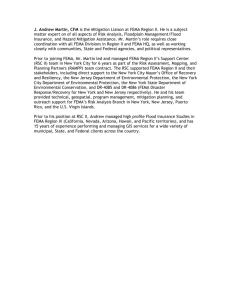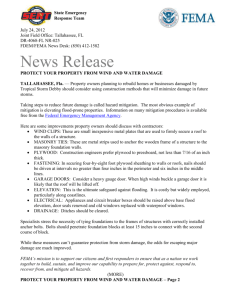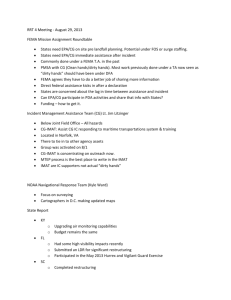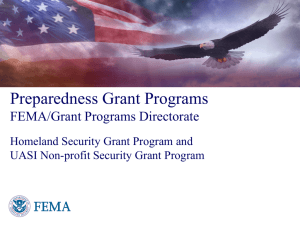File - Jackelin Diaz
advertisement
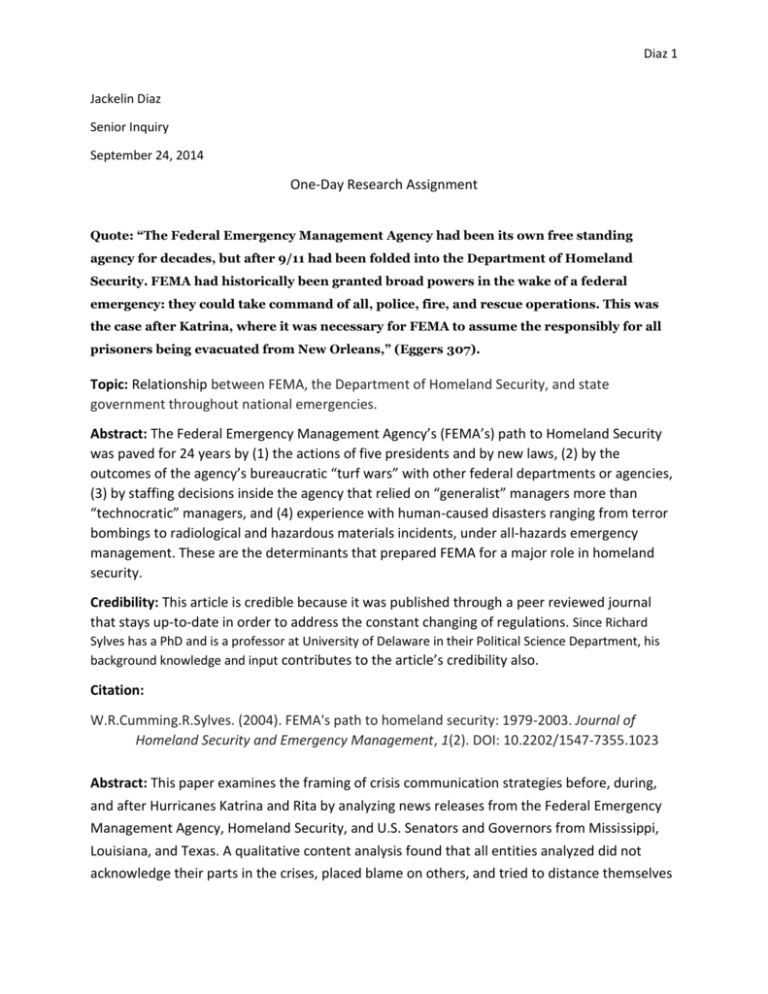
Diaz 1 Jackelin Diaz Senior Inquiry September 24, 2014 One-Day Research Assignment Quote: “The Federal Emergency Management Agency had been its own free standing agency for decades, but after 9/11 had been folded into the Department of Homeland Security. FEMA had historically been granted broad powers in the wake of a federal emergency: they could take command of all, police, fire, and rescue operations. This was the case after Katrina, where it was necessary for FEMA to assume the responsibly for all prisoners being evacuated from New Orleans,” (Eggers 307). Topic: Relationship between FEMA, the Department of Homeland Security, and state government throughout national emergencies. Abstract: The Federal Emergency Management Agency’s (FEMA’s) path to Homeland Security was paved for 24 years by (1) the actions of five presidents and by new laws, (2) by the outcomes of the agency’s bureaucratic “turf wars” with other federal departments or agencies, (3) by staffing decisions inside the agency that relied on “generalist” managers more than “technocratic” managers, and (4) experience with human-caused disasters ranging from terror bombings to radiological and hazardous materials incidents, under all-hazards emergency management. These are the determinants that prepared FEMA for a major role in homeland security. Credibility: This article is credible because it was published through a peer reviewed journal that stays up-to-date in order to address the constant changing of regulations. Since Richard Sylves has a PhD and is a professor at University of Delaware in their Political Science Department, his background knowledge and input contributes to the article’s credibility also. Citation: W.R.Cumming.R.Sylves. (2004). FEMA's path to homeland security: 1979-2003. Journal of Homeland Security and Emergency Management, 1(2). DOI: 10.2202/1547-7355.1023 Abstract: This paper examines the framing of crisis communication strategies before, during, and after Hurricanes Katrina and Rita by analyzing news releases from the Federal Emergency Management Agency, Homeland Security, and U.S. Senators and Governors from Mississippi, Louisiana, and Texas. A qualitative content analysis found that all entities analyzed did not acknowledge their parts in the crises, placed blame on others, and tried to distance themselves Diaz 2 from the crises. State leadership also used a unifying approach where they included themselves in the hardships affected residents were experiencing. Credibility: The article was retrieved from a scientific data base, sciencedirect.com, increasing its credibility at first glance. The journal, Public Relations Review, also contributes to its credibility because it is especially devoted to research papers and commentaries concerning public relations, which is key in FEMA’s interaction with the people it serves. The author of this article also adds onto the credibility of this source, because Amanda Gallangher is a graduate student from Texas Tech University’s College of Mass Communication. Her input is relevant and credible because of her specialty in communication strategy. Although this article does meet an acceptable credibility standard, the journal does not specifically state that its articles are peer reviewed therefore cannot be assumed to be peer-reviewed. Citation: Gallagher, A. H.Fontenot, M., & Boyle, K. (2007). Communicating during times of crises: An analysis of news releases from the federal government before, during, and after hurricanes Katrina and Rita. Public Relations Review, 33(2), 217-219. Abstract: State and local officials complain about their lack of involvement in disaster plans issued by the Department of Homeland Security (DHS). Their complaints point to a common theme: the reorganization that produced the DHS complicated shared governance. States and localities carry out most of the work of homeland security, but the federal government's guidelines and grants shape much of what subnational governments do. This article offers an interpretation of the complaints of emergency management officials and a proposal for dispersing federal homeland security personnel and resources out of Washington, DC, to FEMA regions. Dispersing federal agencies to the regions they oversee offers an alternative to pure centralization and decentralization that combines the task and location specificity of major approaches to federalism. Credibility: This article is considerably credible because it was published through a journal that is devoted to providing the latest trends developments concerning federalism and intergovernmental relations. This journal is also a part of Oxford Journal’s higher ranking sources for teaching and up-to-date sources. To further accredit this article, author Patrick S. Roberts is a professor at Virginia Tech. teaching Public Administration and Policy. Professor Roberts has also recently written a book titled Disasters and the American State: How Politicians, Bureaucrats and the Public Prepare for the Unexpected, released through Cambridge University; a book extremely relevant to Zeitoun’s FEMA correlation. Diaz 3 Citation: Roberts, P. S. (2008). Dispersed federalism as a new regional governance for homeland security. Publius: The Journal of Federalism, 38(3), 416-443. http://www.colorado.edu/hazards/publications/wp/wp108/Claire.jpg This diagram portrays the relation between the Department of Homeland Security and other relevant government agencies. Diaz 4 http://www.cga.ct.gov/2004/images/Public_Health_Prep_Final_Report-6.gif The image above demonstrates the distributed power government agencies hold over state, regional and local organizations. Summary: These articles pertain to my subject of the relation between FEMA, the Department of Homeland Security, and state government throughout national emergencies. The first article refers to how FEMA’s procedures were established. The second article analyzes the communication issues the government (FEMA, Homeland Security, and the state government of Mississippi) faced during both Hurricane Katrina and Rita. Along with the communication analysis, author Amanda Gallangher explores to what extent did the few government agencies responsible for responding to both hurricanes acknowledged their position, blamed one another, and distance themselves from the entire national crisis. The third article discuses the conflict between the state government’s lack of a larger position in responding to certain natural disaster due to set disaster plans organized by the Department of Homeland Security. Diaz 5 After gaining further information on FEMA, the Department of Homeland Security, and state government, I began questioning how well defined their roles and positions are. In order to properly handle major natural disasters or other national emergencies these organizations must corporate in order to be able to focus on the national crisis they all share. But is our government well equipped to handle these emergencies and should they really be “fussing” about who’s to blame instead of how to fix the actual problem?


